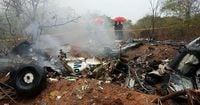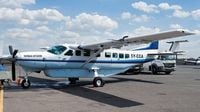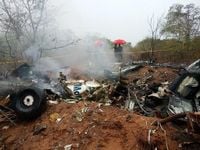In the early hours of October 28, 2025, a routine tourist flight turned into tragedy in Kenya’s coastal Kwale region. A small Cessna 208B Grand Caravan, operated by Mombasa Air Safari, crashed into a hilly, forested area about 40 kilometers (25 miles) from Diani airstrip, killing all 11 people on board—eight Hungarian tourists, two Germans, and their Kenyan pilot. The aircraft, built in 2007, was en route to the world-renowned Maasai Mara National Reserve, a destination famous for its sweeping savannahs and the annual wildebeest migration.
The crash occurred during heavy morning rain, with local authorities and witnesses describing a scene of devastation and confusion. According to the Kenya Civil Aviation Authority, the plane lost altitude just minutes after takeoff from Ukunda Diani Airport. The pilot failed to establish radio contact with air traffic control, and the control tower’s repeated attempts to reach him went unanswered for half an hour. By the time the aircraft’s location was identified, it was too late: the plane had burst into flames, leaving only charred wreckage and unrecognizable human remains.
Witnesses described hearing a loud bang—a sound that shattered the quiet of the forested hills. As rescue teams rushed to the scene, they were confronted by the grim reality: there were no survivors. Local officials, including Kwale County Commissioner Stephen Orinde, confirmed that all on board were tourists, and that the crash site was a difficult, wooded area roughly 10 kilometers from Kwale town. Orinde told BBC News, “The weather is not very good here at the moment. Since early in the morning, it is raining and it is very misty, but we cannot preempt [the findings].”
The exact cause of the crash remains under investigation, with authorities emphasizing that it is too soon to draw conclusions. Still, the adverse weather conditions—heavy rain and mist—were noted by several officials as a likely contributing factor. The Kenya Civil Aviation Authority has launched a formal inquiry, and both local and international aviation experts are expected to be involved. Mombasa Air Safari, the airline at the center of the tragedy, issued a statement: “Our primary focus right now is on providing all possible support to the families affected.” The company also announced plans to set up a family support group and pledged full cooperation with investigators.
The impact of the crash has reverberated far beyond Kenya’s borders. Hungarian Prime Minister Viktor Orbán expressed his condolences on social media, writing, “What a tragedy! Our sincere condolences to families of the Hungarians who died in the plane crash in Kenya.” Hungarian Minister of Foreign Affairs and Trade Péter Szijjártó provided further heartbreaking details, confirming that two minors were among the Hungarian victims. “The Hungarian victims were two families and an acquaintance, with two children among the dead,” Szijjártó stated, adding that the Hungarian consul in Kenya was en route to the crash site to assist relatives. President Tamás Sulyok of Hungary also conveyed his sympathy, underscoring the sense of national mourning.
The German government, too, has been in contact with Kenyan authorities, and efforts are underway to notify and support the families of the German victims. The identification process is ongoing, given the condition of the remains. The airline and authorities have stressed their commitment to transparency and thoroughness as the investigation proceeds.
The Maasai Mara National Reserve, the ill-fated flight’s destination, is one of Africa’s most iconic wildlife sanctuaries. Located west of Kenya’s coastline and a two-hour direct flight from Diani, the reserve draws hundreds of thousands of visitors every year, especially during the wildebeest migration from Tanzania’s Serengeti. Diani itself is a renowned beach resort town, celebrated for its white sand beaches and vibrant tourism industry.
This is not the first time tragedy has struck Kenya’s skies. In 2012, another Mombasa Air Safari plane crashed in the Maasai Mara, claiming four lives. More recently, in August 2025, a medical charity aircraft crashed near Nairobi, killing six people and injuring two others. In 2019, a small plane carrying five people from the Maasai Mara also crashed in western Kenya. These incidents have cast a spotlight on Kenya’s aviation safety record. According to a 2018 safety oversight audit by the International Civil Aviation Organization, Kenya’s performance in accident investigation fell below the global average—a sobering fact that has raised questions about regulatory oversight and crisis response.
As news of the crash spread, images of the burning wreckage circulated on local and international media. The scene was one of utter destruction: debris scattered across the forest floor, the fuselage consumed by flames, and rescue workers combing through the remains. Citizen TV and Kenya Broadcasting Corporation reported that the bodies of those on board had been burned beyond recognition, complicating the identification process and deepening the anguish for families awaiting news.
For Mombasa Air Safari, which operates a fleet of 13-passenger Cessnas serving Kenya’s top tourist destinations, the crash is a devastating blow. The airline has promised to work closely with civil aviation authorities to determine what went wrong, stating that it “will do everything to support” the families of the victims. The company’s chairman, John Cleave, acknowledged the enormity of the loss and the need for answers, both for grieving relatives and for the broader traveling public.
In the aftermath, questions abound: Was the weather solely to blame, or were there other contributing factors such as mechanical failure or human error? Why was there a discrepancy in the reported time of the crash—initially stated as 5:30 a.m. by some authorities, but later revised to 8:35 a.m. by the transport ministry? And, perhaps most crucially, what steps will be taken to prevent such tragedies in the future?
As investigators sift through the wreckage and families begin the long process of mourning, Kenya’s aviation community faces renewed scrutiny. The Maasai Mara will continue to beckon travelers from around the world, but the memory of this October morning—a day when adventure turned to heartbreak—will not soon be forgotten.
For now, the skies over Kwale are quiet, and the world waits for answers.






